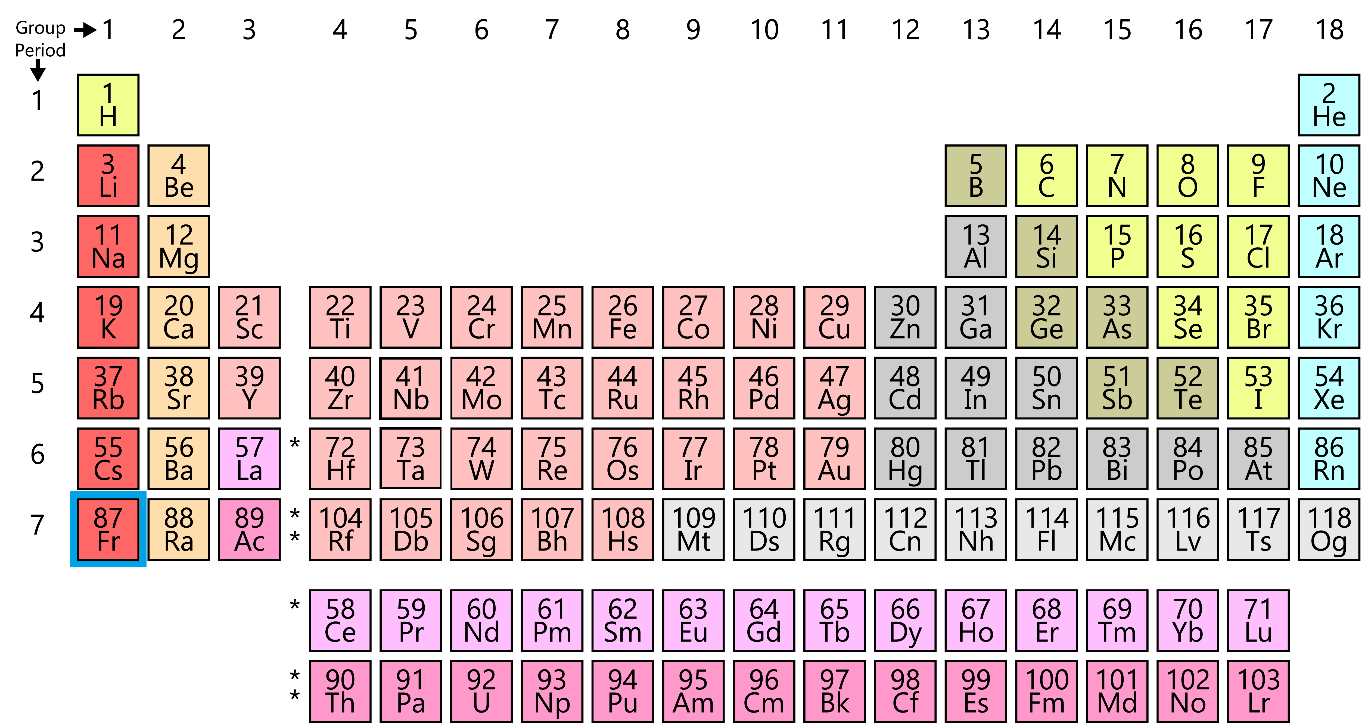
The outer electronic configuration of the radioactive element present in the IA group is:
A. $8{{s}^{1}}$
B. $7{{s}^{1}}$
C. $5{{s}^{1}}$
D. $6{{s}^{1}}$
Answer
552.6k+ views
Hint: Think about the basic characters of an element that make it more likely for it to be radioactive, take into account all the factors like atomic radius, atomic number, atomic mass, and the number of nucleons that the element contains.
Complete answer:
Before working towards determining the answer to this question, let us first look at the number of periods that are present in the periodic table. In the s-block elements, the shell number of the outermost s-shell and the period number of the element are equal. So, if the element is present in the third period of the IA group then the configuration of the outermost shell will be $3{{s}^{1}}$.
We know that there are only seven periods in the periodic table, the number that the outermost s-shell of the atom can go up to is 7. So, the electronic configuration of the outermost shell in the IA group cannot be $8{{s}^{1}}$ due to the non-existence of the eighth period.
We know that as the atomic mass number of atoms increases, the number of nucleons in the nucleus increases and it becomes more and more difficult to keep them together. This leads them to disintegrate and become radioactive. The heaviest element in the group IA will be the one that is present in the seventh period. It has the atomic number 87 and its name is Francium with the symbol $Fr$.

We know that francium with an atomic number of 87 and atomic mass number of 223 is a radioactive element that has a half life of 22 minutes. The electronic configuration of francium is $[Rn]7{{s}^{1}}$.
Hence, the correct answer to this question is ‘B. $7{{s}^{1}}$’.
Note:
Although at first glance it may seem that the element that has the outermost electronic configuration of $8{{s}^{1}}$ will be the radioactive element due to its higher mass. Remember that it does not exist as no element beyond the elements in the seventh period have been synthesized, much less found naturally.
Complete answer:
Before working towards determining the answer to this question, let us first look at the number of periods that are present in the periodic table. In the s-block elements, the shell number of the outermost s-shell and the period number of the element are equal. So, if the element is present in the third period of the IA group then the configuration of the outermost shell will be $3{{s}^{1}}$.
We know that there are only seven periods in the periodic table, the number that the outermost s-shell of the atom can go up to is 7. So, the electronic configuration of the outermost shell in the IA group cannot be $8{{s}^{1}}$ due to the non-existence of the eighth period.
We know that as the atomic mass number of atoms increases, the number of nucleons in the nucleus increases and it becomes more and more difficult to keep them together. This leads them to disintegrate and become radioactive. The heaviest element in the group IA will be the one that is present in the seventh period. It has the atomic number 87 and its name is Francium with the symbol $Fr$.

We know that francium with an atomic number of 87 and atomic mass number of 223 is a radioactive element that has a half life of 22 minutes. The electronic configuration of francium is $[Rn]7{{s}^{1}}$.
Hence, the correct answer to this question is ‘B. $7{{s}^{1}}$’.
Note:
Although at first glance it may seem that the element that has the outermost electronic configuration of $8{{s}^{1}}$ will be the radioactive element due to its higher mass. Remember that it does not exist as no element beyond the elements in the seventh period have been synthesized, much less found naturally.
Recently Updated Pages
Why are manures considered better than fertilizers class 11 biology CBSE

Find the coordinates of the midpoint of the line segment class 11 maths CBSE

Distinguish between static friction limiting friction class 11 physics CBSE

The Chairman of the constituent Assembly was A Jawaharlal class 11 social science CBSE

The first National Commission on Labour NCL submitted class 11 social science CBSE

Number of all subshell of n + l 7 is A 4 B 5 C 6 D class 11 chemistry CBSE

Trending doubts
What is meant by exothermic and endothermic reactions class 11 chemistry CBSE

10 examples of friction in our daily life

One Metric ton is equal to kg A 10000 B 1000 C 100 class 11 physics CBSE

1 Quintal is equal to a 110 kg b 10 kg c 100kg d 1000 class 11 physics CBSE

Difference Between Prokaryotic Cells and Eukaryotic Cells

What are Quantum numbers Explain the quantum number class 11 chemistry CBSE




